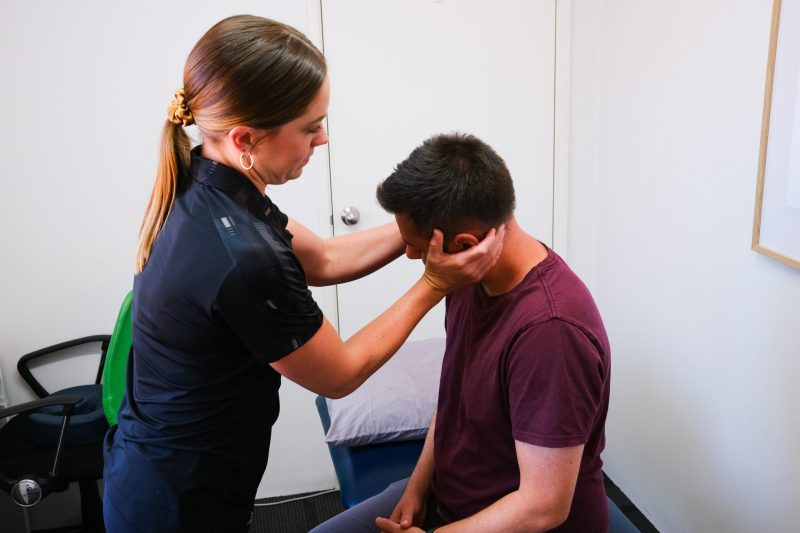It is without a doubt that neck pain is one of the most common issues we see as physiotherapists in the clinic. It is equally as predictable that when asked “what do you do for a living?”, neck pain sufferers almost always will say (guiltily!) “office work”.
We live in a day and age where technology and screens are now an essential part of life, however, it is still a widely known fact that office work will expose you to long periods of static positions, fatigue of postural muscles and structures, deterioration in posture, and inevitably, pain or discomfort that comes along with these factors.
In the past, our first reaction to office/desk-related neck pain would be to jump into action assessing the work environment, the “ergonomics”, and the patient’s posture. Whilst knowing the needs of an individual is still extremely important, we now know that the main issues in regard to desk work revolve around the extremely little amount of movement away from long, continuous, static positions throughout the day – regardless of how perfect their desk set up or posture may be.
As a result, our mantra these days is now “Your next posture is your best posture”.
This means, that frequently changing your position and increasing your movement throughout the day will intercept the factors that contribute to neck pain in office workers.
With this in mind, let’s talk about 4 simple ways you can put this into practice, along with ways to be proactive in preventing and managing neck pain if you work long periods in an office space.
1. Keep moving!
Have regular stretches to do both at work and at home on a daily basis
This is one that most people already know, but only a very small number of people actually do. Stretches can include simple movements to do at your desk or in the office, as well as a couple of basic movements to do at the start and end of the day. The aim of these is to offload the structures that have been under continuous load, allowing them to rest and lengthen out of tight positions. More importantly, it encourages you to keep moving and break up static postures at work and after work. The exercises often provide enough movement and relief to be a major factor in preventing and managing neck pain.
Try these at work:
– Turn your head side to side 20x alternating
– Look up and down 20x alternating
– Whilst sitting, rotating your upper body, as though drawing a bow and arrow – 5x each side
– Stand up and stretch out your chest and shoulders against a wall
Try these at home:
– Lay along a foam roller or along a rolled up towel with your arms wide and palms up. Rotate your head side to side 20x
– Lay on your side and rotate your upper back as you reach behind you, 10x each side. Check out our videos for a demonstration!
2. Stay active outside of work
Strength training is particularly beneficial
This is the big one! If your job is sedentary, then it’s even more important to maintain physical activity on a regular basis outside of work. The movement encouraged with regular exercise will reduce the load and tension on tight and fatigued structures, not to mention it’s many other physical and mental health benefits.
Strengthening the muscles that support your upper back, shoulders and neck is particularly important. We know that strength training also has huge benefits on muscles, joint health, tendons and bone health. However, strengthening your upper back and shoulders will play a vital role in maintaining a comfortable posture, and reducing the likelihood of bad habits – such as slumped shoulders, hinging at the base of the neck, and a forward poking chin posture.
3. Take breaks and move!
It may seem simple or obvious, but almost all patients with neck pain from office work admit that they take limited breaks and lose track of time whilst working. Surprisingly, this is often worse when working from home! The misconception is that these breaks need to be long and will disrupt the flow of work – but any movement away from the prolonged desk position will be of benefit. Here are some ideas:
– Make a tea or coffee
– Refill your water bottle
– Toilet break
– A short walk around the office
– Visit a colleague rather than emailing them
– Stand up to do your exercises
– Relax back in your chair and take some deep breaths
– Mental check in with your posture – are you hunched, rounded, clenching your jaw or generally tense?
– Take a walk in your lunch break
4. Change your position or set up
Whilst ergonomics are no longer the bread and butter, they are still important. Here are some factors you can assess:
– Is your screen too high/low, close/far? This may cause you to strain your eyes, or hold your neck in an awkward position.
– Is your desk to high or chair to low? This may cause you to hunch your shoulders up, and slump down.
– Are your forearms supported? This can take the weight of your arms and shoulders away from your neck.
– Do you sit forward in your chair or back? Try alternating these positions to load different muscle groups and joints, rather than the same areas constantly throughout the day.
– Do you have access to a stand up desk? Alternate between using this and your seated position throughout the day.

